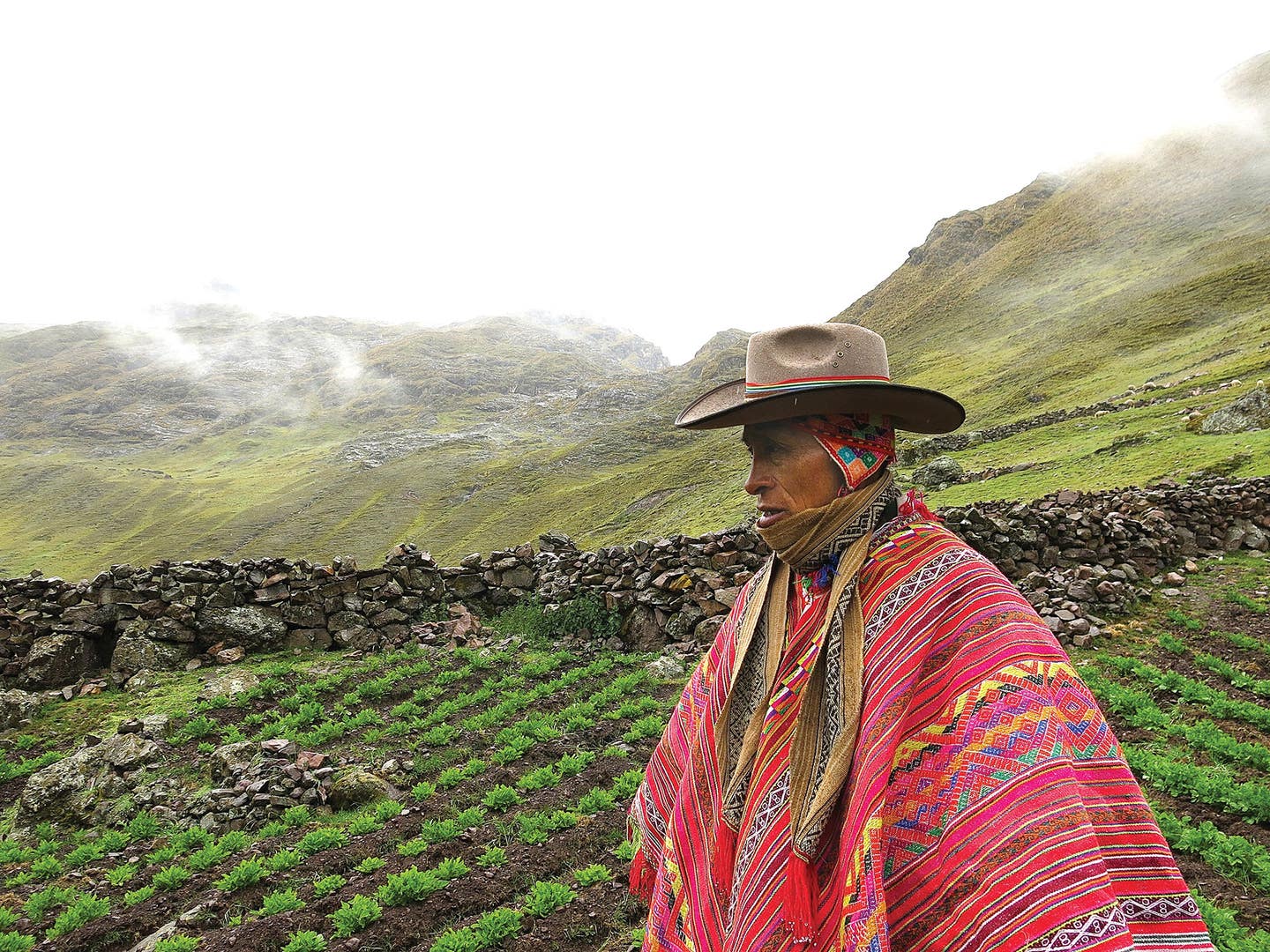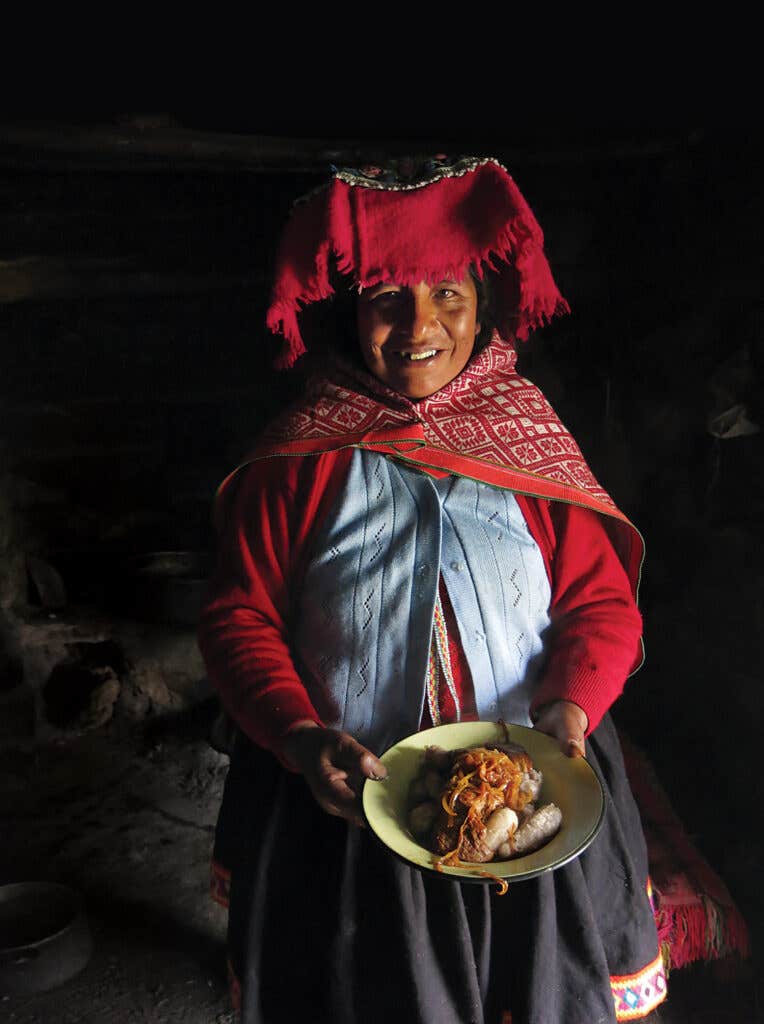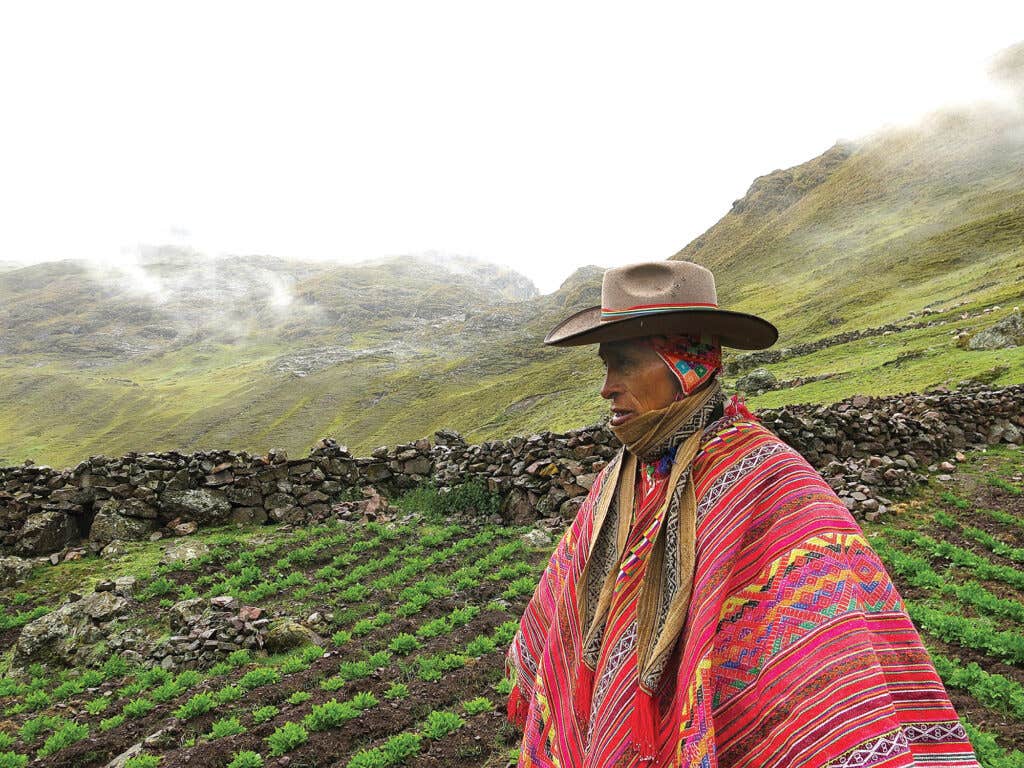
How a Peruvian Farmer is Growing 180 Kinds of Potatoes
High in the Andes, Yieber Cueva tends to Quechua tradition through crops so valued they’re practically sacred

“The path to the sky,” said Yieber Cueva, pointing to a faint track leading upward into the mist. Lowering clouds masked Qullqi Cruz, the Silver Cross, a glacial peak thousands of feet above the unpaved road. Rockslides left gravel streaked like tears down the mountain. It was the rainy season in the Andes. I took it on faith that we were heading in the right direction and clambered after my translator, a stocky former porter on the Inca Trail. My heart pounded.
My head felt as if it might explode. Putting one foot in front of the other took all my will. At this elevation, oxygen deprivation was a threat, and chewing astringent coca leaves, a local remedy for mild altitude sickness, didn’t give me the slightest relief. Yieber paused to wait, his cheerful face framed by a knit wool cap with extravagant tassels.
In Cuzco, everyone kept asking, “When are you going to Machu Picchu?” I couldn’t have cared less about an old pile of rocks swarming with thousands of day-trippers.
“I’m here to see an old man about a potato.” I got some strange looks.
Potatoes predate the ruins anyway. The origins of the potato, Solanum tuberosum, can be traced to the Andes highlands, on the border between present-day Bolivia and Peru, almost eight thousand years ago. According to legend, when the mythical founders of the Inca Empire, Manco Cápac and Mama Ocllo, emerged from the waters of Lake Titicaca, the sun god Viracocha taught them how to sow potatoes. Early hunter-gatherer communities began by domesticating wild plants that grew abundantly around Lake Titicaca. Beyond Cuzco, in the sacred valley of Urubamba, pre-Colombian farmers cultivated other crops—tomatoes, beans, and corn—but the potato proved most suited to the quechua (valley) zones; growers eventually developed frost-resistant species that thrived on alpine tundra as well.
The potato would become fundamental to the Andean worldview; time was measured by how long it took for a pot of spuds to cook. In 1995, a Peruvian-American research team found that families in one mountain valley grew an average of ten traditional varieties, each with its own name. The International Potato Center has documented almost 5,000 kinds indigenous to Peru, many so rare they never get to market but are instead traded within the immediate community where cultivated. They're still central to the Peruvian diet: Lima-based chef Gastón Acurio, who supports a potato diversity initiative with Andean farmers, connected me with the man I sought, Julio Hancco. Acurio buys potatoes from Julio for his Lima restaurant Astrid & Gastón; so does Virgilio Martinez of Lima's world famous Central.
Hancco grows 180 different kinds of potatoes.
As Yieber and I slogged up the path next to the waterfall, the sun cracked through clouds long enough to expose ice fields on the lower face of Qullqi Cruz. A glacial stream threaded down, picking up speed and depth, a turbulent white in a viridian green mountain bowl. We passed cultivated plots where furrows were black, in contrast to the ferrous soil of Cuzco.

By the time we reached the cluster of stone-and-loam brick farm buildings, the wind had picked up and the heavy mist had turned to a drizzle. Julio stood in a doorway, waiting. He wore jeans, heavy work boots, a bronze tracksuit jacket. A jaunty cowboy hat topped his knit cap. His narrow face was weathered, guarded. We entered a bedroom hut, where makeshift cots crowded the earthen floors. Clothing and alpaca skins hung from beams. An outdated calendar and a plastic banner that read “Asociacion de Productores de Papa Nativa de Peru” were tacked to the walls. I settled on a pile of wool blankets. Julio sat opposite.
“How did you wind up growing so many different kinds of potatoes?” I asked.
Some varieties, he explained, were inherited from his father. He traded for others and found more in the markets. “It’s sacred to grow these kinds of potatoes,” he said. “The first person to farm in this area was my grandfather; it is easier in Urubamba, but houses and cities are next to there now.” Urubamba was possibly the first valley where the sacred New World crop trio—corn, potatoes, beans—were grown together, but the pressure of development, even on a small scale, has pushed farmers farther out.
When the rain slowed, I followed Julio outside. He climbed into one of his potato patches, protected from the weather by stone walls. We bent to examine tender sprouts. “Our llamas, alpacas, and sheep eat everywhere,” he said. “That’s how we fertilize the soil. One hand of dried guano together with the potatoes. As they grow, I build up the mound, so the older potatoes, the higher the mound. We plant in August, then harvest in April or May.”
Five acres dug by hand, knees bent, back to the wind. Short-handle shovels lay on the ground, along with two primitive furrow hoes fashioned from crooked tree limbs and hammered sheet metal. Julio pointed to a smaller hoe, fit for a child’s hand.
“That one belongs to my youngest son,” he said. “He wants to be a farmer, too.”
“Do all your children grow potatoes?”
“No. My eldest went to Lima to try his luck there.”
“What does he do for a living?”
Julio tilted his head, golden brown eyes serious.
“Sells potato chips.”
Smoke poured from a chimney under the thatch roof of the kitchen hut. I stepped over the threshold into a room lit by a fireplace filled with glowing coals. Two cats napped close to the heat. Shelves held sugar, cilantro, some onions, cooking pots. A propane tank and a new two-burner stove-top unit were stored under the dining table. Julio’s wife, Rosa, spooned panfried alpaca and caramelized onions with pimentón into shallow bowls. She set another bowl of boiled potatoes on a stool. They looked dull gray, unremarkable. I picked one at random, broke it open with my fingers, and discovered a subtle red veining in the flesh.
“Puka Ambrosio,” said Julio.
"That's what he's named this potato," Yieber said. "Puka means 'red' in Quechua."
It tasted sweet.
You won't find chuño, an age-old freeze-drying technique, in fancy restaurants. Potatoes are left out overnight in low temperatures, then exposed to bright sunlight, and finally crushed to extract more liquid. Used to thicken soups and stews, these squishy, chalk-white preserves suit a locale where electricity and refrigeration remain unimaginable luxuries.
We sat on low chairs around the fire with dishes on our laps. The alpaca was chewy and difficult to cut with a spoon. I peeled a purple fingerling potato, which had a nuttier flavor than the Puka Ambrosio.
“Do you ever leave the mountains?” I asked.
Rosa shrugged.
“In the city, there is not enough air,” she said. “For people used to the highlands, the city is poison.”
Julio agreed. “When we go to Lima, there is no chance for work. Here, I am with the llamas and alpacas. If we want corn, shoes, clothes, money for our children’s education, I take potatoes to Lares, about one hour by bus, and trade them for anything we want. Potatoes are like gold.”
Julio donned a poncho to hike with us to the road. Almost half an hour to trudge up, only ten minutes to tumble back down. He had pressing obligations to other farmers in the valley. We were keeping him from this work. Quechua practice ayni, a form of mutualism. A broad definition of the concept involves the exchange of energy between man, nature, and the universe. Among highland communities, where surviving a poor growing season means sharing at the most elemental level, that translates into bending over in your neighbor's field to help pull weeds.
Before descending, I looked up toward Qullqi Cruz one more time. Still hidden.
“Who is Ambrosio?”
Julio wrapped his neck in a long scarf, his gravelly voice muffled. “Ambrosio was my nephew, my sister’s son. He fell on the mountain and died. I used his name for the potato in order to remember this boy.”
Here, there is poetry in potatoes. Here, a humble tuber can bear a beloved child’s name.
“It’s not easy to live so close to the gods,” I remarked.
Julio nodded curtly.
“Claro.”
Shane Mitchell is the author of Far Afield (Ten Speed Press, October 2016) from which this is adapted.
Keep Reading
Continue to Next Story










